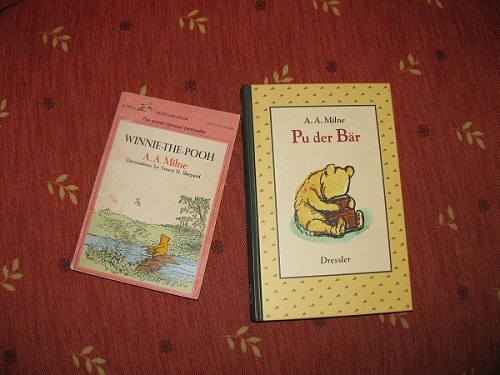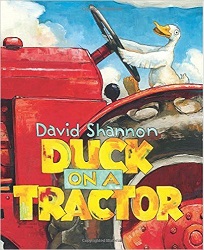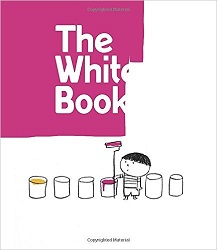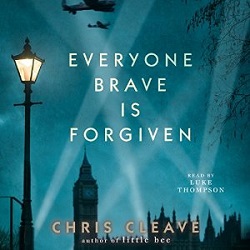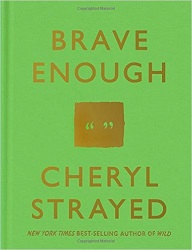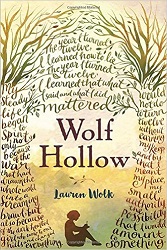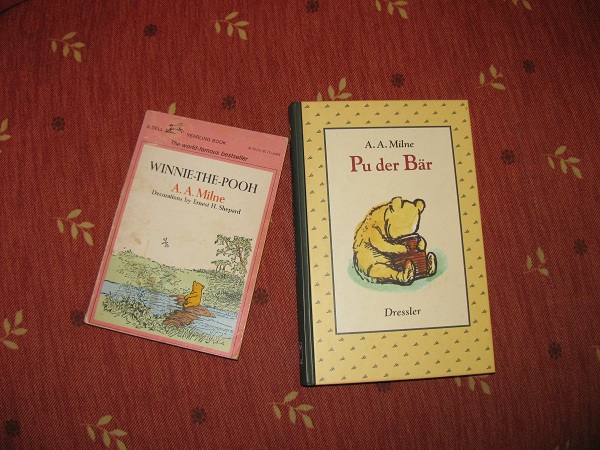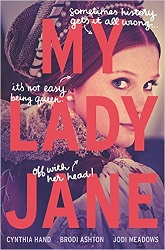Sonderling Sunday – Meeting the Heffalump
It’s time for Sonderling Sunday! That time of the week when I play with language by looking at the German translation of children’s books. Tonight I’m continuing a look at Winnie-the-Pooh, otherwise known as Pu der Bär.
Last week, I began Chapter 5, “In Which Piglet Meets a Heffalump,” In welchem Ferkel ein Heffalump trifft. We left off on page 63, Seite 69. Piglet has dug the Very Deep Pit, and Pooh has placed the bait of honey in the Cunning Trap.
We’ll start with the first sentence of the section:
“And off Piglet trotted to his house TRESPASSERS W, while Pooh made his preparations for bed.”
= Und Ferkel trabte zu seiner Wohnung BETRETEN V, während Pu seine Vorbereitungen für das Ins-Bett-Gehen traf.
“the night was beginning to steal away”
= die Nacht gerade anfing sich davonzustehlen
“sinking feeling” = Gefühl des Sinkens
“murmuring a murmur” = murmelte ein Gemurmel
Okay, I have to reproduce the “murmur”:
“It’s very, very funny,
‘Cos I know I had some honey;
‘Cos it had a label on,
Saying HUNNY.
A goloptious full-up pot too,
And I don’t know where it’s got to,
No, I don’t know where it’s gone —
Well, it’s funny.”
= Dies ist ein echtes Rätsel mir;
Ich weiß, ich hatte Honig hier,
Mit einem Zettel, richtig fein,
Und HONICH drafgeschrieben.
Ein Riesentopf, voll bis zum Rand,
Und jetzt ist er mir durchgebrannt.
Wo kann er hingegangen sein?
Wo ist er nur geblieben?
Try to use this in your conversation:
“It all comes of trying to be kind to Heffalumps.”
= Das kommt alles daher, dass man versucht Heffalumps gut zu behandeln.
And here’s a Useful Sentence:
“The more he tried to sleep, the more he couldn’t.”
= Je mehr er zu schlafen versuchte, desto mehr konnte er nicht schlafen.
“making straight for a pot of Pooh’s honey”
= begab sich schnurstracks auf den Weg zu einem Topf mit Honig von Pu
(I love that word schnurstracks! Google says it means “footprints” or “directly.”)
“eating it all” = fraß ihn völlig leer (“devoured it completely empty”)
“licking its jaws” = die Lefzen leckte
“half-light” = Dämmerlicht
“jiggering about” = herumhüpfte
“Was it Fond of Pigs at all?”
= Konnte es Schweine überhaupt ausstehen?
“a Clever Idea” = eine schlaue Idee
“heffalumping” = geheffalumpt wurde
“Oh, dear, oh, dear, oh, dear!” = Owei, owei, owei!
“bumping” = schmettern
“made a loud, roaring noise of Sadness and Despair”
= stieß einen lauten Ton der Trauer und Verzweiflung aus
“a Horrible Heffalump!” = ein unheimliches Heffalump!
“scampered off” = hoppelte davon
“Help, help, a Herrible Hoffalump!”
= Hilfe, Hilfe, ein unheffliches Heimalump!
“Hoff, Hoff, a Hellible Horralump!”
= Heim, heim, ein heffunliches Hilfalump!
“Holl, Holl, a Hoffable Hellerump!”
= Heff, Heff, ein lumphässliches Limpfahump!
“an enormous big nothing”
= ein wahnsinnsriesengroßes Garnichts
“awful” = grässlich
“Smash” = klirr
“Foolish Piglet” = törichtes Ferkel
And we’ll finish with Christopher Robin’s words at the end of the chapter:
“Oh, Bear! How I do love you!”
= Ach Bär! Wie sehr ich dich liebe!
Now you know how it sounds when you meet a Heffalump and you try to report it in German.
